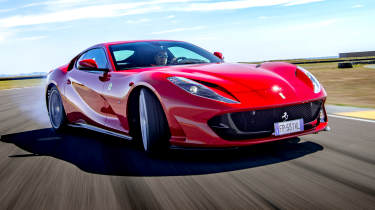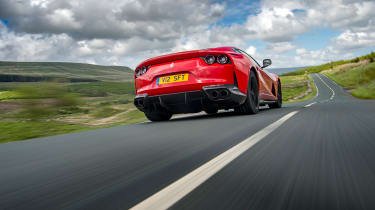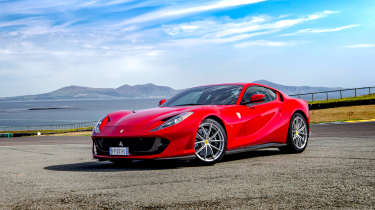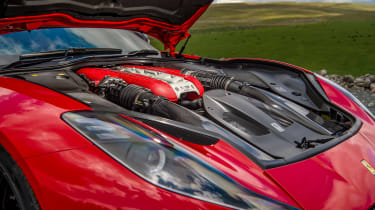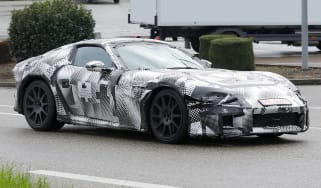Ferrari 812 Superfast (2017 - 2024) review – a V12 GT with hypercar intensity
A pinnacle of front-engined Ferrari engineering, the 812 melded mind-warping performance with a chassis that draws you into the action
The F12 was hardly short of firepower, but you don’t get ahead by standing still, so it came as no surprise when the Italian brand launched an even faster flagship, the Ferrari 812 Superfast. Designed to humble the likes of the Lamborghini Aventador S and McLaren 720S, the Superfast combined an on-the-nose name and a 789bhp V12 to back it up in facing down theoretically more focused supercar contenders.
Essentially a heavily revised F12 that incorporated many of the lessons learned with the fearsome TdF, the 812 used a 6.5-litre development of the incredible V12 that can trace its roots back to the Enzo. It also featured a more advanced chassis with four-wheel steering, plenty of active aerodynamics and Ferrari’s latest suite of driver aids from the day. The result, said Ferrari, was the most exciting yet approachable supercar it had ever made.
The Superfast was an almighty piece of work on Ferrari’s behalf. It was monumentally fast, sounded absolutely out of this world, had a gear change – and, more to the point, a shorter set of gear ratios – that can fray the outer edges of your imagination with its brilliance, and its chassis had mostly been improved to create a deeply seminal range of abilities – on both road and track.
More reviews
It wasn’t perfect, though. Its electronic power steering was more hyperactive than ever in its response and arguably didn’t need quickening. That’s thanks in part to the rear-wheel-steering system that improved turn in, yes, but which also took time to warm to because of the way it behaved. All up, though, the Superfast was a quite extraordinary car.
Ferrari 812 Superfast: in detail
- Engine, gearbox and technical highlights – The 6.5-litre V12 is a work of internal combustion art, delivering searing pace and a symphonic soundtrack.
- Performance and 0-62 time - Explosive yet exploitable acceleration makes the 812 mind-blowingly fast when you want, but docile when you don’t.
- Ride and handling - Traditional front-engine rear-wheel-drive layout results in brilliant balance and involvement, while the ride is surprisingly comfortable in the softest setting.
- Interior and tech - Some of the plastics feel a bit ‘Fiat’, but sense of occasion is unrivalled. It’s packed with kit too.
- Design - Depending on how you feel about the F12, the 812 is either flush with compelling details, or inelegant and fussy.
Ferrari 812: Values, rivals and successors
Price is all a matter of perspective. For some, the c£200k it’ll cost you in 2025 to get behind the wheel of a seven-year old V12 super GT is unthinkable. For others, that’s a £60k discount on what it cost new and indeed, a £130k discount on what a brand new Ferrari 12 Cilindri, the 812’s successor, will cost you without options. Realistically, you could probably buy two older 812 Superfasts for the eventual OTR price most new 12 Cilindris will command.
The thing is, it’s far from half the car. In fact, many prefer the more intense, edgier character of the 812, given how the 12 Cilindri has embraced its softer grand touring side. Indeed, the 812 was sort of split in two in Ferrari’s lineup, the SF90 taking the role of flagship supercar and now the 12 Cilindri, picking up the super GT slack.
From an ergonomic perspective, it’s arguably better too, given it predates all the haptic nonsense. In a sense then, the 812 Superfast is undefeated by its first key rival that’s also its successor.
What other options are there? Well, while the second-generation Aston Martin Vanquish S is what the 812 faced at launch, the DBS (FKA DBS Superleggera), with its punchier twin-turbo V12, arrived to meet it in 2018. Not as accomplished a supercar, flush with flaws both in terms of its dynamics and its cabin, the Aston was still a heart over head choice when new. Now, it represents a really compelling, much cheaper alternative to the still-expensive 812.
Even the Lamborghini Aventador S, Sant’Agata’s V12 flagship from the 812’s time, can be had for around the same money as an 812, if not a little less. Much better than the original the Aventador S may be, but the 812 is the better car, even if it can’t match the theatre and flamboyance of the Bull.
Want a sharper supercar that’s a surprisingly effective GT? The McLaren 720S in spite of its slightly lower figures is just as quick, if not quicker, in the real world, thanks to it being lighter too. It rides really well too, though it doesn’t have the same cabin space and luggage capacity of the 812, not to mention that its turbocharged V8 isn’t a patch on the Ferrari for personality.
Ferrari 812 Superfast specs
| Engine | V12, 6496cc |
|---|---|
| Transmission | Seven-speed dual-clutch, rear-wheel drive |
| Power | 789bhp @ 8500rpm |
| Torque | 529lb @ 7000rpm |
| Weight | 1630kg (492bhp/ton) |
| 0-62mph | 2.9sec (claimed) |
| Top speed | 211mph |
| Tyres |
275/35 ZR20 F, 315/35 ZR20 R |
| Brakes | CCM discs, 398mm and 360mm (F/R) |
| Suspension | Double wishbone front, multi-link rear, adaptive dampers |
| Price new | £262,963 |
| Price now | From £195k |
